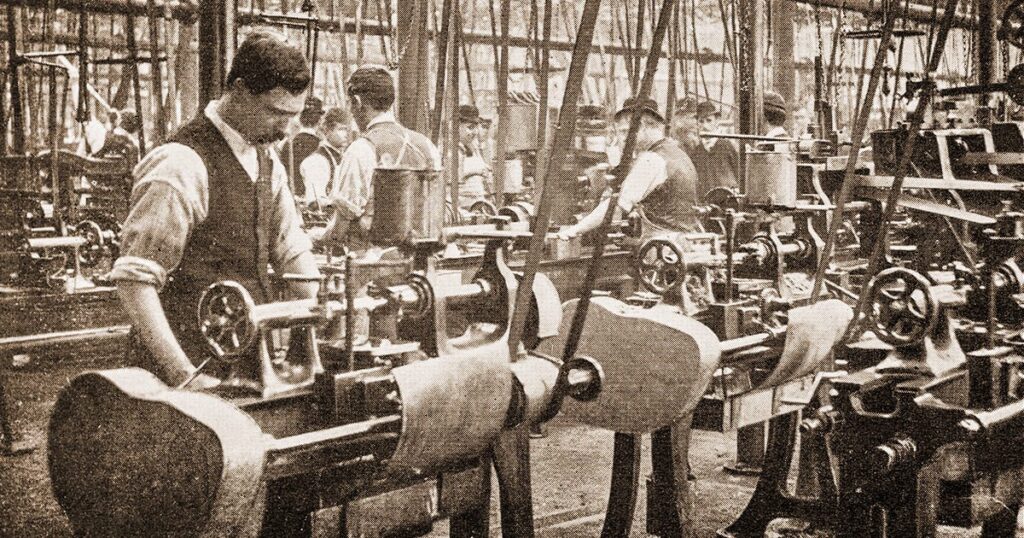The phrase “user experience” has most recently come to represent the experience a user has while they interact with technology, such as a computer or website. However, it was actually coined back in the Machine Age during the 19th and early 20th centuries. As ubiquitous as it is in today’s design and marketing fields, visiting the roots of the term and how it related to customer interactions allows a different vantage point of the term today.
Rooted in interaction.
Spawned by the need to increase efficiencies while streamlining processes during the Second Industrial Revolution (1870–1914), the term “user experience” was more about production and the interaction of workers and their tools. Henry Ford championed the concepts of improving the efficiencies of human labor and machines to use mass production as a way to increase access to products on a much broader scale.
Fast forward to the post-modern era and the Information Age in the later part of the 20th century. User experience was then applied to user-centric design and focused more on the end result of the design process for a product. In Don Norman’s 1988 book (revised edition 2013) “The Design of Everyday Things,” he defines human-centered design as, “an approach that puts human needs, capabilities, and behavior first, then designs to accommodate those needs, capabilities, and ways of behaving.”
Starting in the 1970s, the growth of new technologies and the increased accessibility to data and eventually mobile devices brought us into the Information Age. What we have now is an “information overload.” According to a 2015 study by Microsoft, the human attention span is now eight seconds – less than that of a goldfish. With increasingly faster access and smarter search platforms, customers (users) are now in control more than ever before. We’ve now come into the Age of the Customer.
Expanding the user experience.
Technology has given customers access to information at never before seen levels and speeds. The exchange of information is a two-way street and interactions can happen almost simultaneously. Customers are intimately involved during a greater span of the buyer journey. User experience is no longer production, interaction, and design but each facet of a customer’s journey. Their expectations of what that experience looks like have become drastically more personal and individualized.
A typical buyer journey used to be pretty simple, starting with awareness and ending with decision (purchase). Today, buyer’s journeys should include all the touchpoints customers interact with as they think or process their way through to making the decision to purchase – including product use and customer service follow up.
An example journey:
- Triggers (identify a need)
- Awareness (initial search or exposure)
- Consideration (narrow search)
- Decision (commitment, purchase)
- Transaction (check out process)
- Delivery (dates, tracking, notifications)
- The Box (opening the box, instructions)
- Performance (does the product perform as promised)
- Support (customer service)
- Follow Up (do you care about what they think)
Each step should address what audience personas are thinking at each stage of their journey. This is where brands are able to provide information or resources to match their needs at each stage. In order to develop a great user experience, brands must cultivate brand consistency through the buyer’s journey.
Creating consistent user experiences.
Each touchpoint is a critical piece of the buyer’s journey. A successful user experience is not defined by doing one thing great, it’s doing a lot of little things right. On the other hand, user experience isn’t truly the sum of experiences that a customer has with a brand but one or two moments during the interaction that become notable and ultimately define their overall experience.
Customers receive a lot of unwanted information daily, so keeping their experience with your brand clear and consistent is important for building familiarity. This helps create repeatable, memorable encounters. It’s considered best practice to avoid any kind of conflicting messages across all channels, everything should be aligned to your goals and/or campaigns. Consistency builds familiarity with the brand and what its values are — and familiarity and consistency builds trust and advocacy.
To successfully build trust, what a customer sees and reads on a website should parallel what they experience in store or how they’re treated on a phone call. The colors, language, smells, and attitude all play a role in how a customer remembers their experience and how they’ll relate that experience to their friends and network. Collectively, “user experience” is so much more than the technology we have come to associate it with.
Need help building customer relationships or creating positive user experiences? Workhorse is here to offer our expertise to help grow your business.

